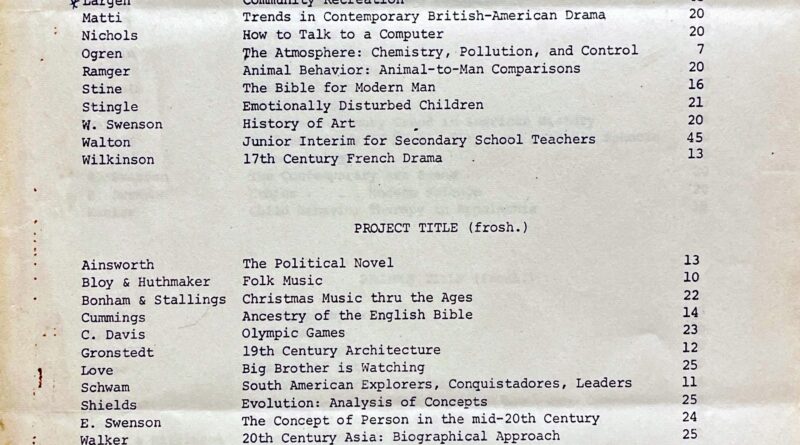Interim courses: a testament to a liberal arts education
What do Christmas music, animal behavior, and the Olympics have in common? Several decades ago, they were all topics of interim courses at Maryville College, a piece of the College’s history that exudes the spirit of the liberal arts but has been somewhat lost as the culture of education shifts its focus from curiosity to career-preparation.
In the 1960s, Maryville College shifted from a two-semester system to a three-term system; courses were held in 10-week terms with longer breaks in between each term, including a four-week break between Thanksgiving and Christmas, which created a need for something to keep students occupied during this time.
Enter interim courses, an addition to the MC experience in 1967 that was immensely popular among students as well as faculty.
Often called “experimental” or “experiential” courses, they were an opportunity for professors to explore topics they wouldn’t otherwise get to teach a class on—for example, a “Christmas Music Through the Ages” course, or a course on the Olympic Games, as seen in this catalog of MC’s very first selection of interim course offerings from 1967.
“Faculty loved doing this,” said Amy Lundell, Maryville College archivist, “you could be a history professor and say ‘I’ve gotten really into crochet,’ and you could teach a class on it.”
Having a four-week period dedicated to interim courses allowed students to get outside the specialized walls of their major and learn new things out of pure interest and curiosity—the heart of a liberal arts education. However, over the years, administrative changes made catalogs of interim course offerings shorter and shorter.
MC switched back to a two-semester system in 1983, moving interim courses to January, before the start of the spring semester. Known as “J-Term” courses, they functioned much like interim classes, although fewer options were offered over the years as they became more optional among faculty.
Then, increased emphasis on students completing internships and professional development opportunities over the summer meant an earlier graduation date was necessary, and in 2018, J-Term became May-Term to shorten the academic year. One consequence of this is that because students are not required to stay on campus for the May term, interim courses are now almost nonexistent.
Interim courses have left fingerprints on MC’s campus in a few ways, such as the required First Year Seminar course that is still offered with a variety of unique topics for students to choose from; or specialty, somewhat nontraditional 149/249/349 courses within academic divisions that change from year to year, like Professor of History Dr. Nancy Locklin-Sofer’s “HIS149: American Social History Through Cookbooks” and “HIS349: History of Murder” courses.
However, the selection of unique courses is smaller nowadays, many are only available to certain majors, and student schedules no longer lend themselves well to taking these courses when they are not required.
Does the disappearance of interim courses suggest a shift away from the liberal arts belief in learning for learning’s sake? Lundell thinks not necessarily and believes it is mostly a lack of demand for this type of class.
“There’s so many other ways people learn now,” Lundell said, “If you wanted to learn something [in the 60s] you had to go to the library and get a book, or find someone else who knew how to do it. But we’re so used to exploring in other ways, for students now I think it’s not as much of a big deal to have classes like this.”
It may not be a mindset shift, and people may still believe in learning for learning’s sake on liberal arts campuses, but the way things are structured now certainly makes it more difficult.
Schedules are so packed with major courses and Maryville College Works requirements that few students have time to pick up a hobby, let alone add a class to their course load just for the sake of learning something new.
In addition, there is a cultural pressure for everything one does to be based in productivity; if every part of your education is not directly preparing you for a career, supposedly, it is not doing its job. When students do have extra time in their schedules, they are not encouraged to learn a new skill or take an unusual history course, but instead told to look for an internship or professional experience.
Professional preparation is, of course, a vitally important piece of the education system, but the spirit of the liberal arts has always claimed to be about more than that. Students of the liberal arts are meant to be encouraged to develop a sense of wonder and curiosity, and to see value in learning beyond professional marketability.
Even schools like Maryville College, which believe so strongly in the liberal arts, struggle to resist cultural norms that place monetization above all else, and it is difficult to encourage curiosity for curiosity’s sake in today’s world, no matter how much we claim to do so.
The spirit of interim courses, however, still exists on campus in small ways, and learning the history of these courses can perhaps help us remember that all learning is valuable, whether it occurs in an organic chemistry classroom or in a course on the history of Christmas music.

